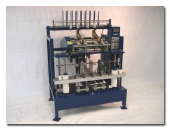Here is a website from an Irish company, called MiniMills. Mini Mills 4 Spindle Spinning Machine
Belfast Mini Mills is in Canada, in our smallest province, Prince Edward Island. Their accent does sound a bit Irish, but they are Canadian.
I was thinking a boat because r ransom mentioned sheep on islands. A boat wouldn't have the same width restrictions that a trailer or truck would have. I'm thinking a larger boat, more like a small ferry, with the same ability to be fixed to a port so vehicles can drive on and off it. Wool could also be moved on and off the boat the same way we move bales of hay into lofts of barns, with a motorised conveyor belt.
He said five pounds an hour. I wonder if he meant 5 lb per minute. That would be 300 pounds per hour.
I think he meant 5 pounds of fleece per hour, which is not the weight of the finished yarn that is produced per hour. Because the yarn is made of fleece wrapped around the sisal twine, the finished yarn is considerably heavier than the fleece used to make it. I have seen this type of yarn made with alpaca fleece, and it is nice for rugs but some of the sisal does poke through, so not likely the kind of rug you would want by a bed, to be stepped on with bare feet, though I imagine the sisal gets softer with time and washing. It certainly does get softer when it is out in the weather for a few seasons!
I am excited about making things like sections of moccasins with wool blend felt. I watched a video recently about the need for our bare feet to be in contact with soil in order to reduce inflammation, so that free electrons which are a big cause of inflammation, can return to the ground.
I am certain leather and wool felt conduct electricity better than rubber shoes or boots. Does anyone have a cheap way of making felt, either using water or felting needles? This is totally a rabbit trail, but now I am thinking of how to build an earthen floor in a basement with a moisture barrier under the floor surface which does not stop the flow of electricity. And making wool and leather shoes that won't stop the flow of electricity from the ground.








